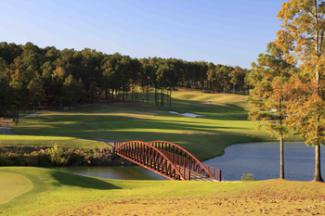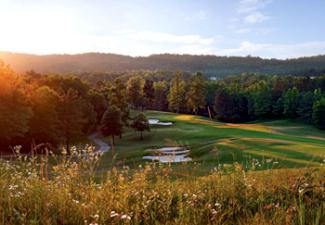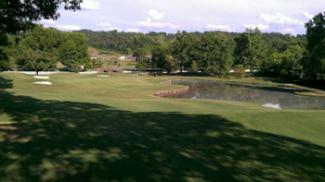Featured Golf News
Plenty of Options at Birmingham's Four RTJ Golf Trail Courses
Birmingham is more than just Alabama's largest metropolis. The city and a nearby suburb also the boast the site with the most holes of any stop on the state's much-ballyhooed Robert Trent Jones Golf Trail.

The 10th Hole at Ross Bridge
Oxmoor Valley, with two 18-hole championship courses and 18 more on a challenging par-3 layout, is set within the city itself, while Ross Bridge, the newest and most daunting of the RTJ Trail's offerings, is the centerpiece of a burgeoning bedroom community in Hoover about 10 minutes up the road. That's 72 holes of golf within a few miles.
Birmingham's RTJ courses are unique among the 11 properties comprising the Trail because all four courses are not part of the same facility and Oxmoor Valley and Ross Bridge operate out of different clubhouses.
The personalities of the two facilities could not be more dissimilar. Ross Bridge, the only site on the Trail to have just one course, is considered by many to be the diamond of the RTJ collection and stands apart from any of the other 10 properties for its opulence.
One of the first facilities built as part of the Trail (which is celebrating its 20th anniversary in 2012), Oxmoor Valley is in sync with the remainder of the Trail's properties: the three courses play out of a clubhouse virtually identical to those at the other Trail sites.
Oxmoor Valley offers golfers the Ridge and Valley as well as the aforementioned Short course. The two regulation tracks here are varied - the Ridge plays atop and along the edge of hills while the Valley moves down off that ridge to the lower levels of the property, but they're still wed in style and overall feel.
During a recent trip to Birmingham I was among a group of writers who first played Oxmoor Valley's Valley course and then Ross Bridge. And while the experience at Oxmoor Valley was superb and comparable to the other venues I've visited on the Trail, Ross Bridge is equal to the best I have played and stayed anywhere in the world.

Oxmoor Valley's Opening Hole
Down, Then Around, Then up Again at Valley
The three courses at Oxmoor Valley are built on former mining land owned by U.S. Steel. The Valley, the more traditional of the property's two regulation tracks, treats the golfer with a course - laid out by RTJ protégé Roger Rulewich - that's routed along two miles of land between mountains and through woodlands, across and around creeks and small lakes.
The course now seems as if it was fashioned on terrain that needed very little adjustment. But Rulewich said the site - which was already affected by its years of use by U.S. Steel - was "very, very rugged, at least getting up and down to the clubhouse area.
"The Valley course spreads out nicely once you got down into the valley," Rulewich added. "Our challenge was to try to get holes that would get you down there and get you back up to some reasonable distance to the clubhouse."
Rulewich solved the up-and-down and then up-again dilemma by putting the starting and closing holes upon the ridge above the rest of the course.
The tee at the 440-yard first hole is suspended some 100 feet above the fairway on a perch where golfers can peer across the valley toward the foothills to the north. The closer - regarded as the Valley course's most difficult hole (it's called "The Assassin") - plays 441 yards back up the hill and involves a tee shot that must carry a gully to a bi-level landing area. From there, the approach is even more uphill to a blind putting surface guarded in front by a deep bunker.
It's little wonder that par-72, 7,167-yard Valley carries a rating of 74.6 and Slope of 130 from its back set of four tees. But with all the fuss made over Valley's beginning and end, its best holes are the ones in the lowlands, down among the serenely isolated woods. Here, players will find a nice selection of holes that end at a variety of putting surfaces and inventive green surrounds.

Oxmoor Valley's Valley Course
A sampler of what's in the valley of the Valley course:
• The 204-yard par-3 second plays slightly uphill to a green guarded by a half-dozen bunkers in front.
• The 564-yard par-5 seventh, where the tee shot is over a creek to a narrow fairway and then through a gap between two bunkers to a green with a small tree at the right-front.
• The ninth, a serpentine 561-yard three-shotter that requires a drive past a huge bunker on the port side, a lay-up over a creek and a precise approach to a rolling, multi-tiered green.
• The 361-yard 11th, by far the shortest par-4 here, gives players a couple of options off the tee and a green that is significantly elevated, preventing the player from seeing the entire flagstick.
• The 506-yard par-5 12th, which might be the most strategic hole on the Valley course. The tee shot is Cape-style, allowing the player to be as aggressive as he chooses. From the fairway, a minefield of bunkers must be navigated to find the green.
• The par-3, 178-yard 16th, which features a full carry over a fronting pond and a back-right pin placement that is devilish at best.

The 16th Green at Oxmoor Valley's Valley Course
• And finally, the 400-yard par-4 17th, which is played uphill all the way, with the approach requiring at least two additional clubs to reach the raised, oval green.
Oxmoor Valley's Valley course is considered one of the most benign of all the tracks on the RTJ Golf Trail, but it is not one to be taken lightly. There are ample challenges here, and if Valley doesn't beat you up it certainly doesn't give anything away.
For more info, see www.rtjgolf.com/oxmoorvalley.

The 17th hole at Ross Bridge
Brawn & Bravado at Ross Bridge
Yes, the course and over-the-top resort at Ross Bridge is only a few miles away from its older sisters at Oxmoor Valley. But there is really no way to even consider the two facilities as relatives, other than they both have the same designer and the "RTJ" nom de plume.
Opened in 2006, big-shouldered Ross Bridge is all about brawn, a track that sprawls across more than 330 acres and stretches a whopping 8,191 yards from the tips.
The rating for those back, black tees is a cartoonish 78.5, but the 135 Slope indicates that for all its length and muscle Ross Bridge has a softer side. Even though it was built to host tournament golf there's plenty here to entice and enamor every range of player.
Rulewich wound Ross Bridge through indigenous landscape and around the 262-room Renaissance Ross Bridge Golf Resort and Spa, one of the nation's finest places to stay. Ten holes play along the banks of two man-made lakes connected by a spectacular waterfall that drops some 80 feet between the ninth and 18th greens. A gristmill added to the waterfall reflects the history of the site, which was, like Oxmoor Valley, owned and mined by U.S. Steel.
The considerable elevation changes of the Shannon Valley are also in play here and the large, glass-smooth putting surfaces provide many tricky pin locations. Rulewich also designed Ross Bridge to resemble a circle, with spokes (like a bicycle wheel) of holes coming back to the hub after three of four holes. It is essentially a bowl with holes radiating around it in ever-decreasing circles.
Just about every hole at Ross Bridge has a notable feature, as the course was specifically designed with 18 "signature" offerings and scads of "wow" factors.
The round starts at a 620-yard, par-5 and a blind drive over a rise to a serpentine landing area with more room left than it appears. The putting surface is uphill and guarded by four bunkers in front and water right and seems as distant as the horizon. And to complicate the issue there is water down the entire left side on the drive and lay-up.

Ross Bridge Golf Course
The 470-yard par-4 third is relatively flat with a lake on the left that pinches the drive and approach. Ross Bridge's initial par-3, the 226-yard fourth, has a peculiar ridge in the center of the green (an "interesting" feature since the hole is difficult enough) and plays back up towards the resort hotel and a halfway house.
The front nine's second par-5 is the 619-yard seventh. It's likely the most scenic of the quartet of three-shotters at Ross Bridge and asks for a drive that's semi-blind and played to the right, where the fairway crests the ridge high above the rest of the course.
The 698-yard 13th is the longest par-5 on the course and one of the few a golfer will play that exceeds the USGA-maximum recommended length of 690 yards. How long is it? It takes a tee ball of 295 yards to reach the forward (teal) tees. The dogleg-left can be shortened by taking an aggressive line over the elbow on the approach, but the hole is still, to say the least, a handful.
The closer, a 487-yard par-4 with water along the entire right flank and the aforementioned waterfall to its right is considered by many players to be the toughest and most beautiful finishing hole along the entire Trail.
There's no doubt Ross Bridge is a very difficult course from the tips (in fact, the scorecard suggests only players at scratch or better even try them). But its width prevents it from becoming a slog or unduly overwhelming. For all the daunting statistics it's actually quite playable.
That said, the recommendation here is to "Play It Forward" and have more fun. For more information, see www.rtjgolf.com/rossbridge.
Steve Habel is one of Cybergolf's world correspondents, contributing news stories, features, equipment and book reviews and personality profiles from his base in Central Texas. He also works as a contributing editor for Horns Illustrated magazine, a publication focusing on University of Texas sports, and is a contributing writer for Golfers' Guide and Golf Oklahoma magazine, Texas Links magazines and Golfers Guide. Habel's main blog (www.shotoverthegreen.blogspot.com) features news on golf and the Longhorns, and another (www.checkinginandplayingthrough.blogspot.com) chronicles his many travels, including playing more than 600 golf courses since 2008. Habel is a member of the Golf Writers Association of America and the Texas Golf Writers Association.
Story Options
 |
Print this Story |
